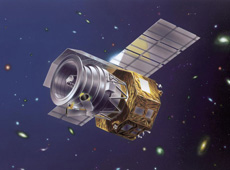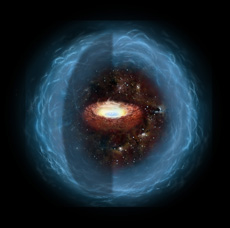

Q. What's the latest news on AKARI?
In August 2007, as scheduled, AKARI ceased its primary mission, including the far-infrared all-sky survey, having run out of its supply of liquid Helium. (Liquid Helium is used for cooling the observation instruments and telescope.) Since then, the temperature of the telescope has gone up from -267°C to -230°C, which requires some adjustment. AKARI's next assignment is to carry out near-infrared observations, which do not require liquid Helium but use a mechanical cooler instead. We have already received many domestic and international proposals for the upcoming observations, and are also planning to invite proposals from the public. We are currently finishing up our preparations and evaluating the performance of the instruments for the next phase of operations.

Infrared astronomical satellite AKARI

Interstellar matter surrounding an active galactic nucleus (artist's concept)
Q. What are your expectations for AKARI's future observations?
I'd like to continue to observe brown dwarfs. We have studied the atmosphere of six brown dwarfs in depth, but I'm hoping to collect data from about 20 in total. We are also scheduled to observe around a massive black hole. It is at the center of our galaxy, and is millions of times more massive than the Sun, radiating extremely intense energy when matter falls into it. The black hole has been difficult to observe as it is enveloped in dense gas, but AKARI has the capacity to investigate the heart of the ultraluminous infrared galaxy. In the observation of the galaxy UGC05101, situated in the constellation Ursa Major, the study of gas molecules in its nucleus has confirmed the existence of gas that's been heated to several hundred degrees Celsius, possibly by intense light coming from near the black hole, as well as the existence of cold gas in the vicinity. We'd like to continue our observations of the vicinity of the black hole to study these structures in the center of galaxies.


Q. What is the research you are particularly interested in?
My personal interest is light from extrasolar planets. I referred earlier to dust disks as a key ingredient for planetary formation, but there is also planetary dust that existed prior to planetary formation. Soon after planetary formation begins, there is likely to be a time when a lot of dust is produced from collisions between small objects that later become planets. Even after planet formation is complete, dust disks can sometimes be seen around mature stars, which, as far as we know, are not supposed to contain original dust. We still do not know the history or features of the dust we are observing, but, whatever the dust is, it is in the midst of undergoing some event.
For example, there is a star called Vega in the constellation Lyra. The 0-magnitude star Vega is astronomically a special star, as it has been used as a baseline to measure the brightness of other stars. Vega is an ordinary star when observed in visible light but is brighter than others in infrared, which was revealed in the 1980s by IRAS, the earlier infrared astronomical satellite. Through its all-sky survey, AKARI has found many new objects to study, including objects with less dust than ever observed before, which, in other words, are dark in infrared. There will be more new findings as we continue our analysis. I'd really like AKARI to reveal to us the evolution of extrasolar planets.
Q. What is the attraction of astronomy for you?
I find astronomy very intriguing. We live on the planet Earth, situated in the universe, and the universe is a fascinating place. It is hard to satisfy all your desires for knowledge, but the process of finding answers is very interesting. The only way to understand the universe is to observe. Personally, I'm most interested in the existence of other intelligent life, and would love the opportunity to see it myself.
We know so little about space. At the beginning of the 21st century, such space explorations as NASA's WMAP (Wilkinson Microwave Anisotropy Probe) mission found that roughly 70 percent of the universe consists of dark energy, which we still don't know much about. Until then, people had thought, based on research that they were getting a pretty good sense of space, but they suddenly realized that in fact they knew almost nothing. The mysteries of space are neverending, but so is our spirit of inquiry. Our exploration continues.
Doctor of Science, Professor, Department of Infrared Astrophysics, Institute of Space and Astronautical Science, JAXA.
Dr. Murakami left the Graduate School of Science at Nagoya University in 1979, and became an assistant at the university's School of Science. In 1988 he joined ISAS, and worked on infrared astronomical observations using balloons and rockets. In 1995, he participated in experiments with the first Japanese infrared space telescope IRTS, which flew on the Space Flyer Unit space platform. Involved in AKARI from its initial development, Dr. Murakami was appointed to his current position as AKARI project manager in April 2005. His specialty is infrared astrophysics. He is also editor-in-chief of ISAS News.
X-ray Astronomy Satellite
Suzaku
Infrared Imaging Satellite
AKARI
Solar Physics Satellite
HINODE
Radio-Astoronomical Satellite
ASTRO-G